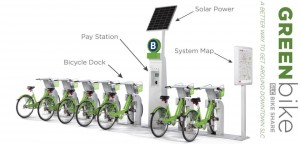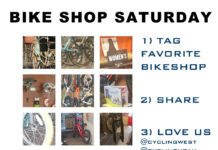Greenbike, Salt Lake City’s Bike Share Program will launch on April 8, 2013 at10:30 a.m. at Gallivan Center (225 South Main St.). Greenbike is a 501(c)3 non-profit organization & public/private partnership between Salt Lake City, The Salt Lake City Downtown Alliance and private sector sponsors like SelectHealth. The following is a an explanation of bike share and it’s history.
What’s a Bike Share Program?
A Bike Share program is a network of many Bike Share stations, where members can take any bike, from any station, as many times as they like for a small membership fee. A 24-hour Access Pass, 7-day or Annual Membership lets you take unlimited 30min trips at no extra charge!
Every time you dock a bike, you get a fresh 30min. If you keep one bike out longer than 30min you get charged a usage fee. Instead of renting one specific bike (bike rental), your GREENbike Membership gives you access to all the bikes at every downtown Bike Share station.
If you’re not riding your GREENbike, don’t chain it up somewhere or keep it in your office. Return your GREENbike to any Bike Share station so someone else can take a ride. That’s why we call it sharing.
To buy a membership, visit greenbikeslc.com. Rates are $5 for 24 hours, $15 for 7 days, and $75 per year. Bikes are free for the first 30 minutes, $2 for the next 30, and $5 for each additional 30 minutes.
Bike Share is not Bike Rental
Bike Rental is paying for a specific bike (road, mountain, etc), for a specific person (guy/girl, big/small), for a specific amount of time (usually 24hours or more). You are responsible for that bike. You need a lock. You load it in your car. You take it in your hotel room.
GREENbikes are designed for one purpose, short trips in the city by people wearing regular clothes and carrying ordinary stuff. They don’t take you up the canyon and they don’t take you down the mountain. The bikes are one sizes fits all (4′ 6″ to 6′ 4″) and the only thing you might have to adjust is the seat.
Bike Share trips are short trips that get you from point A to point B (typically 30 minutes or less). Stations are near other stations and popular destinations for food, drink, and entertainment. “Grab a bike from wherever you are and drop the bike off wherever you end up.”
Bike Share and Convenience
Bike Share removes the standard deterrents of riding a bike in the city and is focused on convenience. You don’t need to bring a lock because you’re not concerned with the bike or its parts being stolen. Your clothes are protected by a full chain guard, dress guard and fenders. A wider seat, upright & step-thru frame makes for a comfortable and reliable ride in an urban environment. My personal favorite part is that you’re not responsible for maintenance.
You don’t have to ask yourself, did I bring my lock? Pump? Spare tube? Lights? Change of shoes? Bike Share creates a scenario that makes it easy for someone to try riding a bike instead of taking a car. And it will result in a large segment of people experiencing cycling for transportation for the first time.
I believe that the average non-biking motorist will try Bike Share because it’s convenient and have a change of heart towards how they feel about cyclists in the road. People are unlikely to change their perspective about something until they become a participant in it.
Think about trying to cross a busy street downtown. When you’re driving, the person in the crosswalk is in your way, and many a muffled expletive has been uttered about how that pedestrian acts like he owns the place or needs to hurry up. After all, you’re driving. You’ve got somewhere important to be!
When you’re the pedestrian, it’s terrifying. Cars are zipping by and all you’re trying to do is cross the street. But you never thought about it until you had the experience.
My hope is that when more people know how it feels to have a car blow past, inches from knocking you over only to arrive at the light seconds before you, that they will realize how scary and frustrating that experience is and not repeat the behavior when they are driving, because life is all about shared experiences.
Bike Share and Mass Transit
Another great thing about Bike Share is that it will serve as an enhancement to existing public transit options in Salt Lake City. Wouldn’t you be more inclined to take Trax if you could grab a bike from a station located at your stop that allows you to drop off the bike at another station that’s at your destination? Bike Share addresses what’s known as the first and last mile problem of mass transit. Currently, people often have to walk several blocks to a couple miles to reach their desired destination once they exit the train. Or it’s inconvenient for them to get to the train in the first place.
Plus you don’t have to bring your bike with you on the train, which can be inconvenient at best or miss your bus entirely because the bike racks on the front of the bus are already full. Each bus can only carry two bikes at any given time (although 3 bikes on busses are on the way).
Brief History of Bike Share
Bike Share programs have been around for a long time in many different forms all over the world. Many started as community projects where donated bicycles, often in poor condition, were all painted the same color and released into an urban center of a city. A “find a bike, ride a bike” mentality. These programs rarely if ever were successful. Bikes were stolen, vandalized or thrown into a river.
Bikes that weren’t destroyed were not maintained and people didn’t know where they were, which makes it hard to plan a commute.
When Salt Lake City Mayor Becker began seeing Bike Share systems utilizing GPS and automated locking systems in Europe and more recently in the U.S. in 2010 in cities like Denverhttp://denver.bcycle.com/, he asked the Salt Lake City Transportation Division to look into it. I was the lead researcher on this project. An RFP was written, but the City didn’t have any funding available at the time. And certainly not enough to come up with the $800,000 it would take to get a skeleton system of 10 or so Bike Share stations up and running. So the Director for the Salt Lake City Transportation Division, Tim Harpst, asked Jason Mathis, Executive Director for the Downtown Alliance, if they would be interested in taking the lead.
The Downtown Alliance has a great track record of serving as an incubator for a variety of initiatives and are still in charge of many projects that benefit our community, including the Downtown Farmer’s Market at Pioneer Park, The SLC Live Green Festival, First Night, Eve, Dine-O-Round, The Holiday Arts and Craft Market and most recently the Jingle Bus: http://www.downtownslc.org/events/jingle-bus .
Jason saw the potential that Bike Share could have on making Downtown an even better place to live, work and play. But it wasn’t until he used Washington DC’s Capital Bike Share that he became a passionate advocate.
In June of 2011, the Downtown Alliance received $25,000 and me from Salt Lake City to see if we could make a Bike Share program happen.
Now remember, we needed at least $800,000 to get a starter system in place. Over 60% of that money would go towards the capital purchase of bicycles, stations, solar panels, docks, freight, installation and assembly. The other costs would go towards operations. Things like maintenance on the bikes, grant writing, community outreach, fundraising, marketing, legal, administrative costs and “rebalancing” the bikes. Rebalancing is moving the bikes around the network of stations so that there are always a given amount of bicycles and open docks available. It wouldn’t be good if you arrive at a station and it’s either completely empty or completely full.
The $25,000 was used to research different models such as profit vs. non-profit, public/private partnerships and a variety of fee-structures. It was difficult to find lots of data because there were only a few cities in the U.S. at this time that had operational Bike Share programs, while others were completing their first year of operations.
We eventually decided that a non-profit model that was a public/private partnership was the best option and began fundraising with the help of the Salt Lake Chamber of Commerce. In February of 2012, we were lucky enough to find a fantastic title sponsor in SelectHealth and so far we’ve raised enough money to purchase 10 stations and 100 bicycles. The more sponsors and grants we find, the more stations and bikes we buy.
Green Bike was created to be Utah’s Bike Share brand. Salt Lake City will be the guinea pig but the long-term goal is to have Bike Share stations across the region, connected by light rail, and to have a universal access pass that is compatible with UTA’s “tap it” pass. The next Utah municipalities to connect to SLC Bike Share with their own satellite bike share systems will most likely be Ogden and Provo.
For more information, visit greenbikeslc.com.












